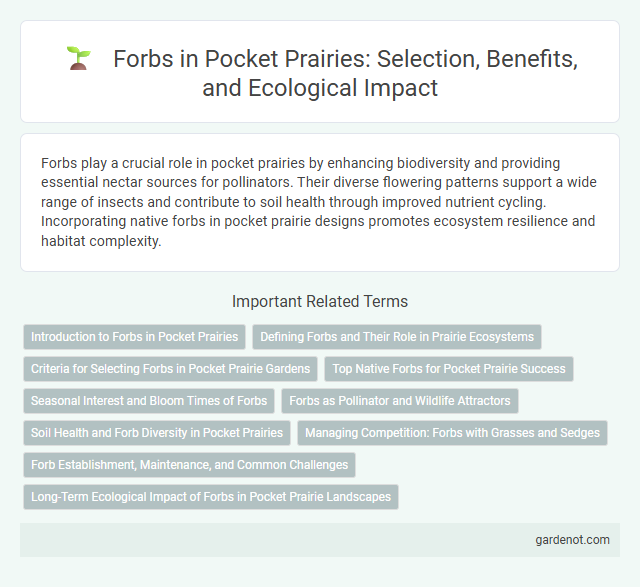Forbs play a crucial role in pocket prairies by enhancing biodiversity and providing essential nectar sources for pollinators. Their diverse flowering patterns support a wide range of insects and contribute to soil health through improved nutrient cycling. Incorporating native forbs in pocket prairie designs promotes ecosystem resilience and habitat complexity.
Introduction to Forbs in Pocket Prairies
Forbs are broad-leaved, herbaceous flowering plants essential to pocket prairies due to their role in enhancing biodiversity and supporting pollinators like bees and butterflies. These plants contribute to soil health by fixing nitrogen and providing ground cover that prevents erosion. Incorporating a variety of native forb species such as Echinacea, Black-eyed Susan, and Milkweed ensures a resilient and vibrant pocket prairie ecosystem.
Defining Forbs and Their Role in Prairie Ecosystems
Forbs are broad-leaved herbaceous flowering plants distinct from grasses and sedges, playing a crucial role in pocket prairie ecosystems by enhancing biodiversity and providing essential resources for pollinators and wildlife. Their diverse species contribute to soil health through nitrogen fixation, organic matter accumulation, and improved nutrient cycling, supporting the overall resilience of prairie habitats. The presence of forbs fosters a balanced ecosystem by offering habitat complexity, food sources, and promoting ecological interactions among insects, birds, and mammals.
Criteria for Selecting Forbs in Pocket Prairie Gardens
Selecting forbs in pocket prairie gardens requires prioritizing native species that support local pollinators and exhibit drought tolerance for sustainable growth. Forbs with diverse bloom times enhance continuous food sources for bees, butterflies, and other beneficial insects throughout the growing season. Soil adaptability and compatibility with surrounding grasses ensure healthy plant communities and prevent invasive spread.
Top Native Forbs for Pocket Prairie Success
Top native forbs like purple coneflower (Echinacea purpurea), black-eyed Susan (Rudbeckia hirta), and wild bergamot (Monarda fistulosa) are essential for pocket prairie success due to their adaptability and ecological benefits. These forbs provide critical nectar and pollen sources for pollinators such as bees and butterflies while enhancing soil health and biodiversity. Incorporating diverse native forbs boosts resilience against pests and drought, ensuring a sustainable and vibrant pocket prairie ecosystem.
Seasonal Interest and Bloom Times of Forbs
Forbs in pocket prairies offer vibrant seasonal interest, with peak bloom times typically occurring from late spring through early fall. These herbaceous flowering plants attract pollinators and provide a dynamic display of color that changes throughout the growing season. Selecting a diverse mix of forbs ensures continuous blooms and supports ecosystem health across varied seasonal cycles.
Forbs as Pollinator and Wildlife Attractors
Forbs play a crucial role in pocket prairies by providing essential nectar and pollen resources that attract a diverse range of pollinators, including bees, butterflies, and hummingbirds. Their vibrant blooms and extended flowering periods support wildlife by enhancing habitat complexity and food availability. Incorporating native forbs boosts biodiversity and promotes a healthy ecosystem within pocket prairie environments.
Soil Health and Forb Diversity in Pocket Prairies
Forbs in pocket prairies play a crucial role in enhancing soil health by promoting nutrient cycling and improving soil structure through their diverse root systems. Increased forb diversity supports beneficial microbial communities and enhances soil organic matter, leading to improved water retention and reduced erosion. Maintaining a rich variety of forb species in pocket prairies boosts ecosystem resilience and contributes to sustainable urban soil management.
Managing Competition: Forbs with Grasses and Sedges
Managing competition between forbs and grasses or sedges in pocket prairies involves balancing species to optimize biodiversity and ecosystem function. Forbs often compete with grasses and sedges for nutrients, water, and light, requiring selective planting and periodic disturbance such as controlled burning or mowing to reduce aggressive grass dominance. Promoting a diverse forb community enhances pollinator habitat and supports soil health, essential for sustaining pocket prairie resilience.
Forb Establishment, Maintenance, and Common Challenges
Forb establishment in pocket prairies requires selecting native species adapted to local soil and climate conditions to ensure successful germination and growth. Maintenance involves periodic weeding, controlled burns, or mowing to reduce competition from grasses and invasive plants, promoting forb diversity and coverage. Common challenges include invasive species encroachment, soil erosion, and inconsistent moisture levels, which can hinder forb survival and overall prairie ecosystem health.
Long-Term Ecological Impact of Forbs in Pocket Prairie Landscapes
Forbs in pocket prairie landscapes significantly enhance biodiversity by providing abundant nectar and pollen resources that support pollinator populations and other wildlife. Their deep root systems improve soil structure, increase water infiltration, and promote nutrient cycling, thereby contributing to long-term soil health and resilience against erosion. The sustained presence of diverse forb species fosters ecosystem stability and adaptability to environmental changes over time.
Forb Infographic

 gardenot.com
gardenot.com